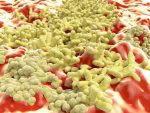Gut Microbiome Changes in Female Mice Better Mirror Those in Patients
Written by |

Sex-specific changes in the gut microbiome and associated metabolites came before disease progression in a mouse model of Rett syndrome, a study demonstrated.
Notably, the study showed that female Rett mice models mimicked the syndrome’s microbial and molecular signatures better than male Rett mice, which are primarily used in research.
“Future animal studies investigating RTT [Rett] disease pathology and treatments should include females in order to effectively translate findings to human RTT patients,” the scientists wrote.
The study, “Sex disparate gut microbiome and metabolome perturbations precede disease progression in a mouse model of Rett syndrome,” was published in the journal Communications Biology.
More than 95% of Rett syndrome cases are caused by mutations in the MECP2 gene, which encodes the MeCP2 protein that regulates the activity of other genes, and plays an essential role in brain development and function.
Because the MECP2 gene is located on the X chromosome, the syndrome occurs primarily in females as they possess two X chromosomes. Males have one X chromosome, and those with these mutations rarely survive infancy.
Although most Rett patients are female, the majority of preclinical studies in animal models have been conducted in modified male mice. Well-characterized female Rett mouse models are needed to understand the disorder’s underlying mechanisms and support investigations into potential therapies.
In addition, Rett is increasingly being recognized as a multi-system disorder due to the production of MeCP2 protein in almost all cell types. Beyond the brain-related symptoms seen in Rett, digestive tract problems affect up to 80% of patients.
Recent studies also suggest that the collection of microbes within the digestive tract — the gut microbiome — is altered in Rett patients. However, whether this change is due to the disease or differences in diet and feeding behaviors is unclear.
To provide insights, researchers at the University of California, Davis MIND Institute, examined the gut microbiome and the metabolites it produces (metabolome) in a female mouse model of Rett throughout disease progression. (Metabolites are the intermediate or end products of metabolism.)
The team first characterized neurological, motor, and bodyweight progression in both male and female Rett mouse models. As expected, Rett mice of both sexes showed neurological and motor symptom progression compared with healthy mice (controls), with disease onset and symptom severity greater in male mice.
But female Rett mice showed earlier onset of progressive weight gain throughout the disease course than did males, “demonstrating progressive yet distinct onset differences in neurological, motor, and metabolic phenotypes between sexes,” the researchers wrote.
Fecal samples were analyzed to identify microbial signatures across Rett’s progression. Over time, female Rett mice showed a 3.7% increase in the abundance of a group of bacteria called Firmicutes and a 3.4% decrease in Bacteroidetes compared with control mice. Males showed the opposite change, with a 5.1% decrease in Firmicutes and a 5.2% increase in Bacteroidetes.
Notably, the enhanced growth of Firmicutes in female Rett mice was due to a greater abundance of Clostridia, “a class of microbes that regulate the gut-brain axis,” the researchers noted.
To the team’s surprise, two measures of gut microbe diversity — an indicator of digestive health — rose with disease progression in female Rett mice relative to healthy mice. Although there were no significant differences in microbe diversity over time between male Rett mice and controls, a significant difference in microbe diversity between male and female Rett mice was seen at five, six, and eight weeks of age.
Findings were similar when examining individual microbe families, demonstrating that “the gut microbiome is dynamically altered during disease progression in both female and male [Rett] mutants, however, there are distinct sex-specific signatures of specific families,” the researchers wrote.
Experiments then looked for links between microbiome alterations and neurological, motor, and metabolic symptoms. In both female and male Rett mice, certain microbe families were associated with neurological scores, gait, and body weight, which were persistently altered at different time points throughout disease progression.
Significant Rett-related microbe changes in female mice were seen as early as eight weeks, two weeks before any significant neurological symptoms appeared.
By measuring levels of immune signaling proteins (cytokines) in fecal samples, the team also showed that female and male Rett mice had distinctly altered cytokine profiles across disease progression.
Levels of interleukin-4, a pro-inflammatory cytokine, were higher in Rett females but lower in males relative to healthy controls. Similarly, females — but not males — showed increasing pro-inflammatory interleukin-1-alpha compared with controls. The female Rett mice also showed increased fecal pellet passage (a way of assessing gut motility) as early as six weeks, but not at all time points measured.
Rett females, but not males, had significantly higher fecal short-chain fatty acids (SCFAs) — metabolites produced by gut microbes relevant to nervous system metabolism — across the disease course compared with healthy mice.
Alterations in biologically-relevant metabolites called biogenic amines and lipids (fat-like molecules) over time were also evident in Rett female mice compared with males, again “illustrating the dynamic relationship between [Rett] and the fecal metabolome across disease progression,” the scientists wrote.
Associations were also found between the presence of fecal metabolites and disease-related features, including age, gait, body weight, and neurological scores in female Rett mice, providing further evidence that “fecal metabolites may be sensitive indicators of RTT progression, especially in females,” the researchers wrote.
Finally, the team investigated whether the increased fecal lipids, including SCFAs, seen in female Rett mice indicated problems with lipid absorption in the digestive tract leading to changes in brain lipid composition. Analysis of brain tissue showed a clear difference between female Rett mice and healthy mice. In males, differences were seen in only five lipids.
There were strong inverse relationships between fecal lipids at nine weeks of age and brain lipids at 19 weeks of age in females, “indicating that lipids that were increased in fecal matter were associated with decreased lipids in the brain cortices,” the investigators wrote. “Many of the lipids that were decreased in [the Rett brain] relative to [healthy] female littermates are critical for neuronal function.”
“Thus, these data suggest that decreased absorption of lipids in the GI tract may negatively impact brain lipids in females” with Rett syndrome, they added.
“Critically, our data demonstrated that female [Rett] mutant mice recapitulate molecular signatures of human [Rett] more consistently than male [Rett] mutants, including alterations in the gut microbiome, metabolome, and cytokine profiles,” the scientists concluded.
“We also discovered that lipid malabsorption may contribute to [Rett] neuromotor phenotypes [characteristics] in females, a potential new pathway that should be studied further for potential therapies.”






